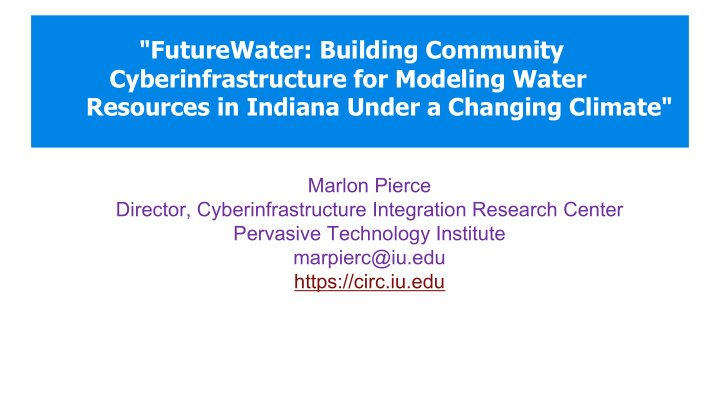



"FutureWater: Building Community Cyberinfrastructure for Modeling Water Resources in Indiana Under a Changing Climate" Marlon Pierce Director, Cyberinfrastructure Integration Research Center Pervasive Technology Institute marpierc@iu.edu https://circ.iu.edu
Acknowledgements Prof. Chen Zhu’s Lab Cyberinfrastructure Integration Research • Prof. Chen Zhu Center • Prof. Jennifer Brand, • Dr. Sudhakar Pamidighantam, • PfEC postdoc • Eroma Abeysinghe • Assist Prof, UW- • Jun Wang Stevens Point • Marcus Christie • Jingrui Wang • Bidisha Abesh • Lei Gong Research Data Services • Rich Huang University Information Technology Service • Alan Walsh • Esen Tuna
Purdue Indiana Climate Assessment Report (2018)
Will Indiana have enough water in 2050s and 2100? Hydrologic cycle Water (hydro cycle) is sensitive to temperature and precipitation Indiana Climate Change Impacts Assessment Report (2018)
This is a complex modeling problem We need regional forecasts for We need to model different types future climate conditions of droughts Meteorological drought: not enough rain Soil moisture drought: soil dries out from excessive heat Streamflow (hydrological) drought: not enough water in watersheds
This is a complex cyberinfrastructure problem The core models require Lots of bookkeeping significant computing Data preparation steps are also Details need to be reviewable complex and need to be Some scientists may want to try carefully recorded alternative scenarios Accessible and interactive Data analysis on model outputs Open to future exploration by needs to be preserved other scientists
Can we increase transparency about how long-range climate forecasts are made? This is a complex communication problem Can we deliver results to different groups of people?
Science Gateway Cyberinfrastructure SCIENTIFIC SOFTWARE AS ONLINE DATA ANALYSIS COMMON MIDDLEWARE A SERVICE BUT TAILORED USER INTERFACES Science gateways promote greater access to models, software, and results: reproducibility and transparency
USDA SWAT Model ( Soil & Water Assessment Tool ) (1) Weather Data (including precipitation, temperature, wind) Input (2) Digital elevation model SWAT Employed (3) Land Use / Land Cover (4) Soil types (5) Ponds/Reservoir/Lakes (6) Water Resources Management scenarios • Prediction of water cycle in 2050, 2080, 2100 • Ensemble of 10 global climate model forecasts • Under two future greenhouse gas emission scenarios • Predict future water availability and management scenarios for Indiana
• Input preparation and output analysis are where the science happens Beyond • Choices for how inputs are Software as created need to be auditable, transparent a Service • Outputs need to be Findable, Accessible, Interoperable, and Reusable (FAIR)
We have developed a hydrological model for Wabash basin covering 65% of Indiana and simulated to the Year 2100 Topography Land cover Soil Map Hydrography
Model input data Hydrography Elevation Soil types SOIL SURVEY STATE SOIL GEOGRAPHIC GEOGRAPHIC DATABASE (STATSGO) (SSURGO)
Model input data Land u use / / l land c cover National Land Cover Dataset + National Agricultural Statistics Service Cropland Data layer Reclassified from 17 classes to 7. SWAT land Raster Percent of use type ‘VALUE’ Watershed SOYB 1 26.1 CORN 5 25.3 WATR 11 1.0 URML 22 3.2 FRSD 41 19.3 FESC 81 10.3 AGRL 82 14.8
Model input data Tile Drains
Model input data Lakes, wetlands, and ponds Reservoirs
Calibrate the model Fit streamflow and validate model to historical data
Calibration and validation using historic daily streamflow data from US Geological Survey Warm Up Calibratio Validation n
Explore validated model under future climate scenarios: IPCC’s Coupled Model Intercomparison Project (CMIP5) Climate forecasts for 10 2 different future These are global models different climate models emission scenarios with global outputs through 2100 RCP 4.5: Moderate emissions Downscale to get regional forecasts RCP 8.5: High emissions There are rigorous methods for this
Downscaled CMIP5 Climate Change Scenarios Kyuhyun Byun & Alan Hamlet
Re Results: Pe Percent change - an annual al
2020s 2050s 2080s Results: Percent change - monthly
Results: Percent change - monthly 2020s 2050s 2080s
Science gateways can change the way that results are communicated General public (teachers, students, policy makers, etc.) Teaching (class projects etc.) Hydrological models Specialist stakeholders (government management offices, industry, environmental groups, external researchers) Publish a paper and then collect dusts PfEC researchers (Hoosier Resilience Index, migratory ecology, invasive species studies, Lower Wabash project, Green infrastructure, etc.)
Living Output • Users need to be able to explore the data • Power users may want to create scripts themselves
https://futurewater.indiana.edu
Science Gateway Cyberinfrastructure
• Leaders in NSF’s XSEDE and Science Gateways Community Institute projects. • “Full Stack” approach to science gateway cyberinfrastructure. • We develop innovative, open source science gateway software. • We operate gateways for clients • We collaborate with scientists • We teach applied distributed systems 28
• Web interface and middleware that helps What Is a scientists access scientific software and data Science on research computing systems Gateway? • Support user communities
Gateways manage users’ identities Science They record what you do for Gateways you as digital objects Support They allow you to save and Science reuse your digital objects And share them with your collaborators
In Short, Science Gateways... PROVIDE SUPPORT ARE SCIENTIFIC REPRODUCIBILITY CYBERINFRASTRU SOFTWARE AS A CTURE FOR FAIR SERVICE SCIENCE.
Apache Airavata • Apache Airavata is open source software for building science gateways
SciGaP: Science Gateways Platform as a Service • We run Apache Airavata as a multi-tenanted cloud service • Support over 30 science gateways • We federate resources • We connect gateways to over 45 different computing clusters
Periodically CMIP6 will come updating regional out in 2021 forecasts The Future Build more interactive tools of FutureWater Empower users to build their own tools Open the input preparation process for power users
Recommend
More recommend